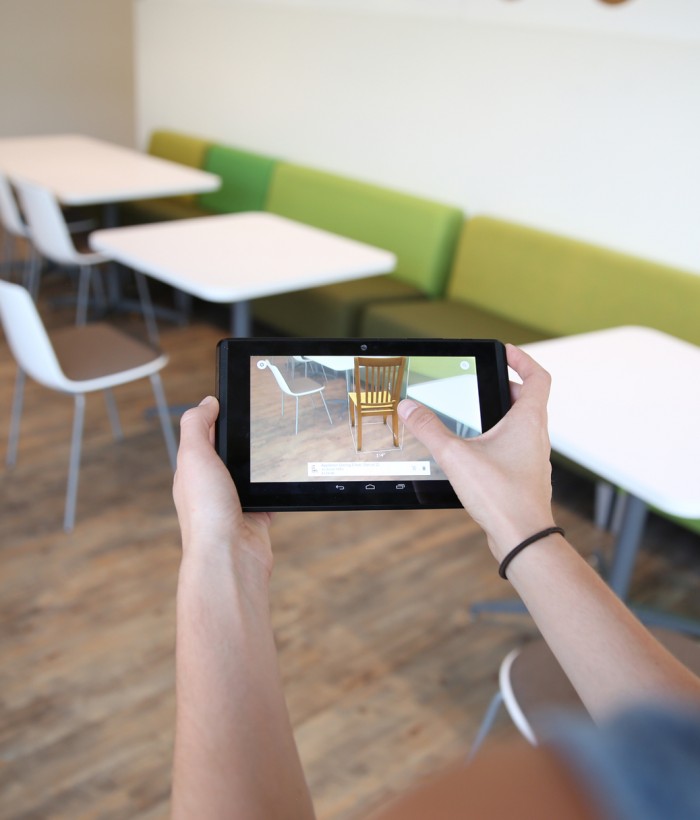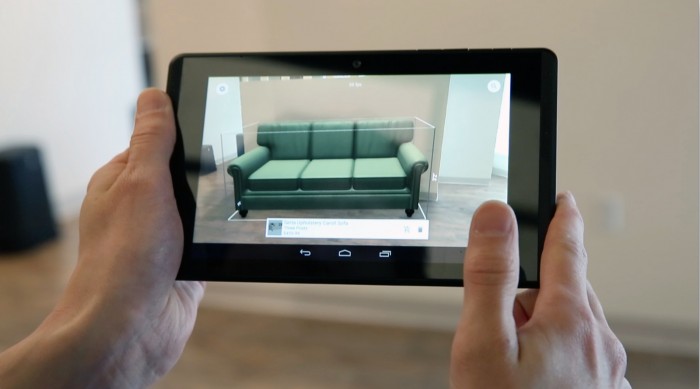How Stores Will Use Augmented Reality to Make You Buy More Stuff
Is this lamp too big for that side table? Will this couch fit under that window? How far will this chandelier extend from the ceiling when installed?
These are the types of questions online furniture retailer Wayfair aims to answer with its new augmented-reality app, WayfairView, which lets users place full-scale 3-D virtual models of Wayfair products in real settings. Users select images of furniture or décor from Wayfair’s online catalogue and use the touch screen on their phone or tablet to position the objects on their room’s floor, walls, or ceiling. The app will be available on a new Lenovo phone this year and on more devices later.
“WayfairView should give people more confidence to buy from us without worrying whether something’s the right size,” says Mike Festa, the director of Wayfair’s R&D division.
Augmented reality and virtual reality have not yet hit the mainstream, but retailers are hoping to change that. They see “virtual commerce” as a way to address common shopping annoyances and engage consumers. Lowe’s has installed “Holoroom” kiosks, which apply virtual reality to home design, in 19 stores across the country and is preparing the launch of an augmented-reality app. In April, Ikea released a VR app focused on customizing virtual kitchens. Sephora’s mobile app and website have a feature that lets users apply virtual cosmetics to their faces. Last year, the North Face placed VR headsets loaded with footage of California’s Yosemite National Park and Utah’s Moab desert in some of its stores to get shoppers excited about outdoor adventure.

Consumers seem at least curious about augmented- and virtual-retail experiences. A survey conducted in February by Walker Sands, a digital marketing agency, found that 55 percent of consumers think virtual-reality applications will influence their buying decisions in some way. A third of consumers said they would be likely to shop more with e-commerce retailers that offer VR features.
The recent maturation of Google’s augmented-reality platform, Tango, is inspiring retailers to invest more in virtual commerce. Google began working on Tango in 2012 as part of its in-house technology incubator, Advanced Technology and Projects. For years, Tango mostly consisted of developer prototypes that used computer vision to enable devices to understand their relative positions. But a few months ago, Google started talking to retailers about Tango’s ability to overlay virtual objects on users’ surroundings. The promise: shopping experiences that would be more immersive than regular online shopping and more realistic than virtual reality, all without requiring cumbersome headsets.
WayfairView is one outcome of these collaborations. In my tests, I found the app helpful, not only for gauging how products would occupy a given space, but also for assessing whether they matched the current décor. I could see, for example, how a Wayfair chair looked inside a busy, open-plan office, then drag the chair around the room and even rotate it by touching the tablet’s screen. I could also view the chair from different angles (the app changes perspective as users move) and share the setup with others by taking a screen shot. If I really liked the chair, I could buy it by pressing a button that would take me to Wayfair’s regular Android app.
The one drawback is the product models don’t look 100 percent real, since they are digital re-creations, not photos. Wayfair is devising ways to scan its products for complete accuracy.

Lenovo’s recent unveiling of the first Tango-enabled consumer smartphone, the Phab2 Pro, is also boosting retailers’ confidence in augmented reality. The $499 phone, which will go on sale in September, is regarded as more likely to popularize augmented reality than pricier, stand-alone devices such as the $3,000 Microsoft HoloLens. Festa and his colleague Shrenik Sadalgi think the Phab2 Pro’s introduction will prod other smartphone makers to add depth- and motion-tracking sensors to their devices. “We believe Tango apps could run on most smartphones by 2018 or 2019,” says Sadalgi.
Lowe’s is making an even bigger bet on Tango. The home improvement chain has agreed to sell the Phab2 Pro before the end of the year, marking its first foray into smartphone retailing. And Lowe’s will offer its own Tango-enabled app, Lowe’s Vision, which lets users place virtual flooring, wall trim, furniture, and appliances in rooms.
“Tango is fun and intuitive without requiring complex equipment or skills,” says Kyle Nel, executive director of Lowe’s Innovation Labs division. “This technology is an important step forward in our vision for how AR and VR will shape the way our customers design, build, and enjoy their homes.” Nel thinks contractors, architects, and designers will buy the phone to help their clients conceptualize projects and he hopes that consumers will buy it, too.
It’s not clear whether any of these technologies will actually increase sales. Ikea says its VR kitchen app is “still in startup stage.” Lowe’s declined to comment on how its VR Holorooms, which it started installing in stores in 2014, have affected revenue. Nevertheless, Nel sees value in experimenting. “By testing and rolling out different AR and VR technologies and applications, we have the opportunity to learn how customers engage with these solutions and stay ahead of their rapidly changing expectations and differing needs,” he says.
Keep Reading
Most Popular
Large language models can do jaw-dropping things. But nobody knows exactly why.
And that's a problem. Figuring it out is one of the biggest scientific puzzles of our time and a crucial step towards controlling more powerful future models.
How scientists traced a mysterious covid case back to six toilets
When wastewater surveillance turns into a hunt for a single infected individual, the ethics get tricky.
The problem with plug-in hybrids? Their drivers.
Plug-in hybrids are often sold as a transition to EVs, but new data from Europe shows we’re still underestimating the emissions they produce.
Stay connected
Get the latest updates from
MIT Technology Review
Discover special offers, top stories, upcoming events, and more.